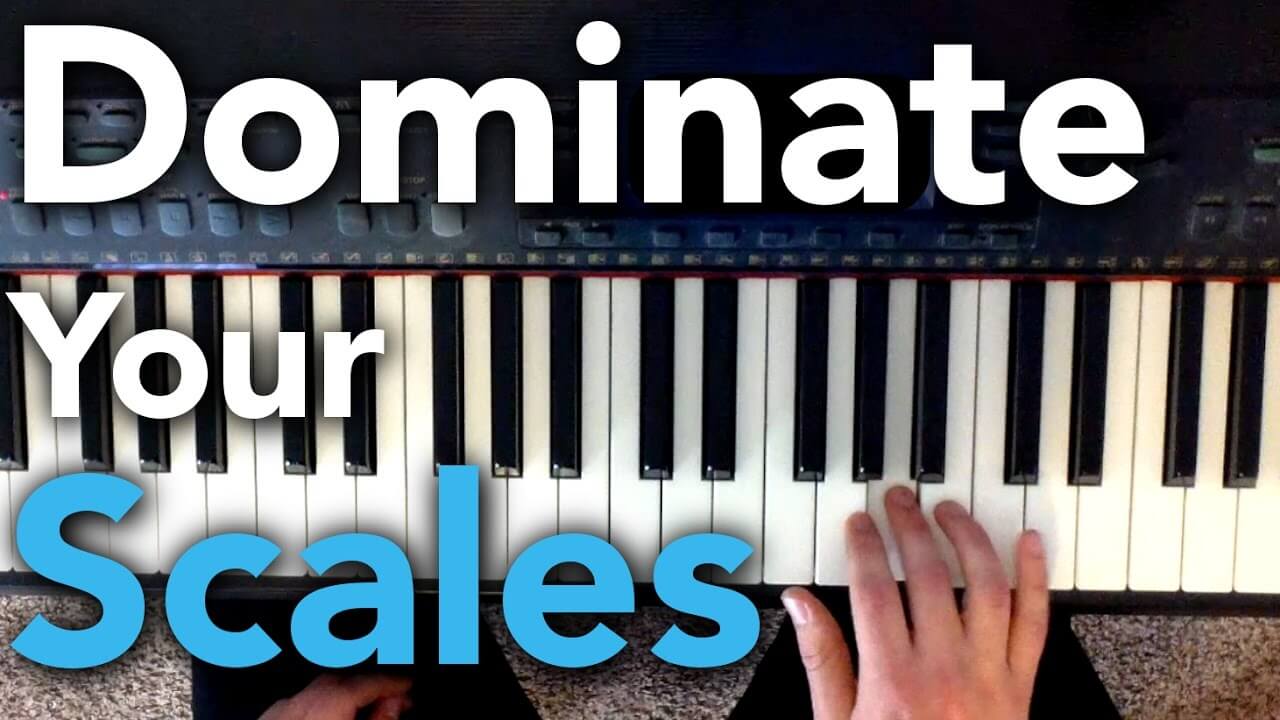With just 10 minutes per day of practice I’m going to show you how you can absolutely dominate your piano scales. You’ll develop smooth, even, fast piano scales without all of the frustration.
After reading this blog post, get right to a piano and start practicing. The sooner you can apply these lessons, the better. You’ll get way more out of this if you take action right away.
Why Piano Scales are Important
Want to get that “At home” feeling on the keys? Want to feel more comfortable? Piano scales are a way to give you that comfort.
I also think scales are the best drill for developing finger strength and coordination. Yes, there are other drills like arpeggios, octaves, and the finger gauntlet, but scales seem to be the best.
Furthermore, piano scales are the quickest way to master different keys. It’s almost like a music theory tool as well as a technique tool.
Lastly, scales are a widely accepted tool by most piano teachers. In fact, almost EVERY piano teacher will have you practice scales. Point blank, scales are worth your time.
I want to give you a full system for learning your scales that will save you time and limit your frustration, drawing on lessons I’ve learned after making countless mistakes. That system, including strategies, tactics, and a routine, is coming up in this blog post. We’ll hit your piano scales from every angle possible.
Practice Strategies
There are a variety of practice strategies I’ll mentioned, but the first is the “Quick Thumb Technique.” I’ve talked about this strategy in my free Become a Piano Superhuman Course and I think it’s really helpful.
The Quick Thumb Technique
One of the biggest causes of sloppy piano scales is when beginners play the first three notes, but then it gets choppy at the fourth note when they have to do a weird thumb under thing. They have to get their thumb from a C all the way to an F and there’s this big jump, but it’s difficult to do. What you want is to have your thumb closer to the F right away so you don’t have to do that big jump in the first place.
What you need to do is tuck your thumb under as you’re playing the D and E. To be clear, this is a beginner technique. As you advance with your scales you’ll eventually use a thumb over technique.
When you sit down at a piano to practice this technique all I want you to start with is playing the first two notes, that’s it. All I want you to do is practice moving your thumb under at the same time you’re playing that second note. Then, you’ll add the third note and do the same thing. And then the fourth note. It’ll feel awkward and weird at first, but after you’ve played it a few times it’ll start to feel normal.
Practicing in Rhythms
This is my go-to strategy, you don’t just use this for scales, and it’ll really help you drill different parts in.
There are four different rhythms you’re going to practice:
- Slowly (Play this two times)
- Rhythm Number One (Long, Short Long, Short Long – Played four times)
- Rhythm Number Two (Short Long, Short Long, Short Long – Played four times)
- Rhythm Number Three (Long, Short Short Short Long, Short Short Short Long – Played four times)
- Rhythm Number Four (Short Short Short Long, Short Short Short Long – Played four times)
The key with playing these rhythms is to play them accurately, taking your time to make sure you do so.
Metronome Ramp Up
The metronome ramp up strategy solves the problem of being able to play a scale slow, but when you try to speed it up it gets sloppy, choppy, and uncoordinated. The reason why this happens is because people try to go from 0 to 100, not taking time to progress appropriately.
What the metronome ramp up does is takes your scale from a very slow tempo and gradually and systematically progresses to a higher tempo.
Start with your metronome, set it to a slow tempo, and play it four times at that tempo. Next, bump the tempo up by 8 to 15 BPM and play it again four times. You’ll do the same thing with another bump of 8 to 15 BPM.
At this change of 8 to 15 BPM you’ll barely notice a difference, so it won’t seem any faster or freak you out. Eventually you’ll hit your max tempo where you start making mistakes. What you need to do then is focus on really trying to play it four times with no mistakes. You might not be able to do this. It might really be your max tempo, and if it is, that’s fine, but you have to try to push yourself a little past your comfort zone.
The most important thing, after you’ve played the max tempo where you’re making mistakes, is to go back down to a slower tempo where you can play it four more times. If you don’t do this, your body is going to remember that sloppy, fast playing – you don’t want this because it’ll drill in sloppy habits. Normally I’d say never practice sloppy, but you have to push yourself sometimes to see where your boundaries are.
Now that we have these different strategies I’m going to show you how to put these together into a routine.
Developing a Routine
Here’s an example routine you could use. Remember, each one of you are at different levels, so this is just meant to show you what a routine could look like.
- Monday: Hands Separate – Quick Thumb, and Rhythms
- Tuesday: Hands Separate – Metronome Ramp Up
- Wednesday: Hands Together – Rhythms
- Thursday: Hands Together – Metronome Ramp Up
- Friday: Hands Separate – Thumb Under Isolation
- Saturday: Hands Together – Added Note Strategy
Notice, you’ll always start hands separate the first day. It always seems to go better when you practice this first.
Another thing, always use a count UP timer. I can’t explain why, but using a stopwatch always seems to keep you more motivated. The reason I don’t use a countdown timer is because I don’t want to be disrupted if I get into the zone.
Also, always make scales the first thing you work on each day. Doing scales is not only a great warm up, it’s tremendous for developing technique. Technique is the foundation of being a great piano player and anything you can do to improve this is worthwhile.
Furthermore, when it comes to setting goals, don’t try to learn everything at once – pick one scale per week.
The Piano Scales Learning Curve
When it comes to learning piano scales it’s not a linear learning curve – it’s exponential. The first week of learning scales, let’s say you learn C major. The next week, you learn G major. The first six notes are all white notes and when you play the G major notes you’re actually playing some of the same ones as C major. They build off each other.
Scales are hard at first, but once you hit that click point, you’ll accelerate your progress and they’ll become much easier.
The Biggest Mistake with Learning Scales
What is the biggest mistake when it comes to learning scales? Sloppy practice.
There are a few things I would call sloppy practice – using the wrong finger to play a note, playing the scales choppy, or just playing the wrong notes. Every time you play something sloppy, you’re literally getting WORSE at piano.
My suggestion is simple – learn it right the first time. Don’t try to play too fast or even try to play hands together right away. Take your time to learn it right. Think QUALITY over quantity.
Want to take your piano scales to the next level? Check out my eBook, Lightning Fast Piano Scales.

